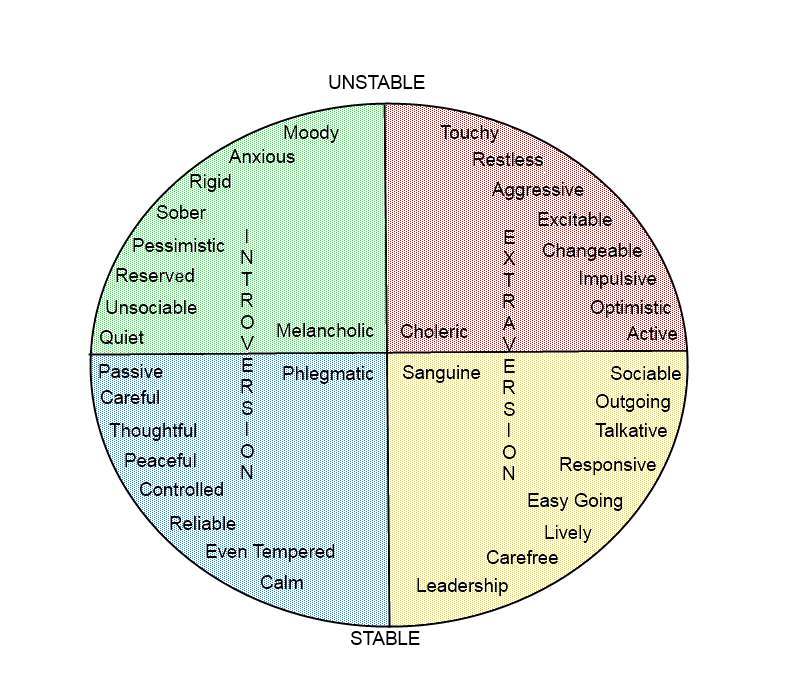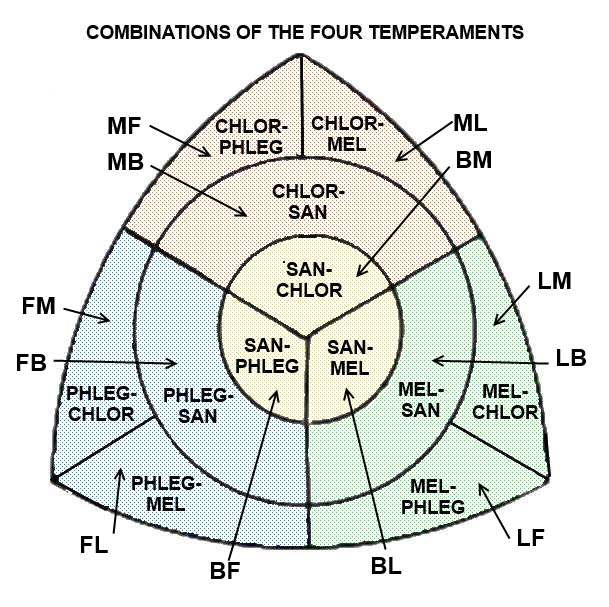The idea of four temperaments has been woven into the study of personality for at least two thousand years. Because of its dominance and longevity it has to be mentioned. The four temperaments are listed below along with a simple description.
- sanguine enthusiastic, active, and social
- choleric short-tempered, fast, or irritable
- melancholic analytical, wise, and quiet
- phlegmatic relaxed and peaceful
H.J. Eysenck devoted a lot of his research to rescuing the ancient temperaments from the clutter they accumulated through the centuries. His work in this area appears in almost all the modern introductory psychology textbooks because it is a significant part of the factor analysis approach. The following diagram is often used to illustrate how his theory describes temperament.

Besides showing the relationship between the temperaments this chart says some important things about introversion and extroversion. The Phlegmatic/Endomorph is an introverted function because digestion is dealing with food that is inside. The Melancholic/Ectomorph is processing, sorting, and weighing information that is “in”. The Choleric/Mesomorph is focused on moving things in the world “out there” and is therefore extraverted. The Sanguinic/Sensory system is focused on orientation by searching for information about the world. A simple formula for the Extraversion/Introversion continuum is [Choleric + Sanguine] – [Melancholic + Phlegmatic].
Now look at our 12 part triangle. Some temperament systems shorten the names of the temperaments when they speak of combinations.
- Phleg for Phlegmatic
- Chlor for Choleric
- San for Sanguinic
- Mel for Melancholic

NOTE: {F= Fat} {M= Muscular} {L= Linear} {B=Balance}
After you locate your body type on this chart you might want to search google for information about the temperament for your body type. Here are some links to description of various temperament combinations. Some religions have a special interest in temperament theory so don’t be surprised if some of these descriptions draw upon Biblical characters to illustrate examples of the various temperament blends.
http://www.selfgrowth.com/articles/Warfield2.html
This site lists the 12 basic combinations of temperaments under the heading Temperament and Personality.
http://www.goingthedistance.org/pages.asp?pageid=18155
A site oriented to a religious perspective of blends of the four temperaments.
http://www.oluwoleogunranti.com/afash/temperaments.htm
A condensed discussion of temperament blends.
This is a good place to face the real problem with test based results as a means to gain self knowledge. All self-report tests have the same problem whatever their claims to reliability or validity. They all lack a benchmark. They lack a standard or point of reference. At the present time somatotype is the best scientific candidate we have for explaining personality because it is actually measuring something physical. Whatever you want to say about Sheldon he brought the connection between mind and body into the realm of serious scientific research. The “testers” who play around with their ethereal adjectival dimensions have yet to come up with a universal explanation of what makes up personality. The influence of body-type may be diminished or augmented by the environment but it is a persistent force. It is also a biological force that can be understood objectively or non-verbally because it can be physically pointed to much as you would point to other physical phenomena.
This doesn’t mean that psychological testing is of no use. The results of the many tests need to be viewed as a combination of several viewpoints; what a person feels or believes they they need or want, what they believe is their current situation, the behavior they feel is unimportant at the moment, and their beliefs about what they need to avoid in order to survive. At any point in time we are making adjustments that could affect the outcome of how we self report on a test.
Once you know the hierarchy of your body systems based on body-type you can then look at the area that matches your test results and compare how close it comes to your natural temperament. From there you can figure out the forces that are pushing you out of the zone of your natural core. The further away your test results are from your natural zone the more serious the problem.